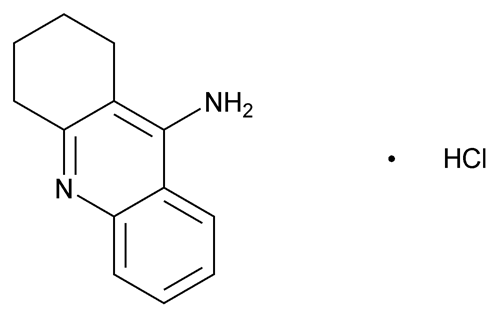Tacrine Hydrochloride
(tak reen hye'' droe klor' ide).
» Tacrine Hydrochloride contains not less than 98.5 percent and not more than 101.5 percent of C13H14N2·HCl, calculated on the anhydrous basis.
Packaging and storage—
Preserve in well-closed containers.
Identification—
B:
The retention time of the major peak in the chromatogram of the Assay preparation corresponds to that in the chromatogram of the Standard preparation, as obtained in the Assay.
Water, Method I  921
921 :
:
 between 6.0% and 8.0%.
between 6.0% and 8.0%.
Residue on ignition  281
281 :
:
 not more than 0.1%.
not more than 0.1%.
Heavy metals, Method II  231
231 :
:
 not more than 0.001%.
not more than 0.001%.
Chromatographic purity—
0.05 M Triethylamine solution, Mobile phase, System suitability solution, and Chromatographic system—
Proceed as directed in the Assay.
Standard stock solution—
Use the Standard stock preparation as prepared in the Assay.
Standard solution—
Dilute 1.0 mL of the Standard stock solution quantitatively, and stepwise if necessary, with Mobile phase to obtain a solution having a known concentration of about 0.001 mg per mL.
Test solution—
Use the Assay stock preparation.
Procedure—
Separately inject equal volumes (about 10 µL) of the Standard solution and the Test solution into the chromatograph, record the chromatograms for not less than 20 minutes, and measure all of the peak areas. The area of any single peak obtained from the Test solution is not greater than the area of the tacrine hydrochloride peak obtained from the chromatogram of the Standard solution: not more than 0.1% of any individual impurity is found; and not more than 0.2% of total impurities is found.
Content of chloride—
Transfer about 150 mg of Tacrine Hydrochloride, accurately weighed, to a 100-mL beaker. Dissolve in 40 mL of methanol and 10 mL of water, and acidify with 1 mL of nitric acid. Titrate with 0.1 N silver nitrate VS, determining the endpoint potentiometrically, using suitable electrodes (see Titrimetry  541
541 ). Each mL of 0.1 N silver nitrate is equivalent to 3.545 mg of chloride. Not less than 13.6% and not more than 14.4% is found.
). Each mL of 0.1 N silver nitrate is equivalent to 3.545 mg of chloride. Not less than 13.6% and not more than 14.4% is found.
Assay—
0.05 M Triethylamine solution—
Dissolve 13.8 mL of triethylamine in 1900 mL of water. Adjust with formic acid to a pH of 3.0, dilute with water to 2000 mL, and mix.
Mobile phase—
Prepare a filtered and degassed mixture of 0.05 M Triethylamine solution and acetonitrile (87:13). Make adjustments if necessary (see System Suitability under Chromatography  621
621 ).
).
System suitability solution—
Dissolve suitable quantities of USP Tacrine Hydrochloride RS and 2-aminobenzonitrile in Mobile phase to obtain a solution containing about 100 µg per mL and 25 µg per mL, respectively.
Standard stock preparation—
Dissolve an accurately weighed quantity of USP Tacrine Hydrochloride RS in Mobile phase to obtain a solution containing about 1 mg per mL.
Standard preparation—
Dilute 1.0 mL of the Standard stock preparation with Mobile phase to obtain a solution having a known concentration of about 0.1 mg per mL.
Assay stock preparation—
Transfer about 100 mg of Tacrine Hydrochloride, accurately weighed, to a 100-mL volumetric flask, dissolve in and dilute with Mobile phase to volume, and mix.
Assay preparation—
Transfer 1.0 mL of the Assay stock preparation to a 10-mL volumetric flask, and dilute with Mobile phase to volume to obtain a solution having a known concentration of about 0.1 mg per mL.
Chromatographic system (see Chromatography  621
621 )—
The liquid chromatograph is equipped with a 243-nm detector and a 4.6-mm × 25-cm column that contains 5-µm packing L11. The flow rate is about 1.5 mL per minute. Chromatograph the System suitability solution, and record the peak responses as directed for Procedure: the relative retention times are about 0.48 for 2-aminobenzonitrile and 1.0 for tacrine hydrochloride; the resolution, R, between 2-aminobenzonitrile and tacrine hydrochloride is not less than 10.0; and the column efficiency is not less than 5200 theoretical plates. Chromatograph the Standard preparation, and record the peak responses as directed for Procedure: the relative standard deviation for replicate injections is not more than 0.41%.
)—
The liquid chromatograph is equipped with a 243-nm detector and a 4.6-mm × 25-cm column that contains 5-µm packing L11. The flow rate is about 1.5 mL per minute. Chromatograph the System suitability solution, and record the peak responses as directed for Procedure: the relative retention times are about 0.48 for 2-aminobenzonitrile and 1.0 for tacrine hydrochloride; the resolution, R, between 2-aminobenzonitrile and tacrine hydrochloride is not less than 10.0; and the column efficiency is not less than 5200 theoretical plates. Chromatograph the Standard preparation, and record the peak responses as directed for Procedure: the relative standard deviation for replicate injections is not more than 0.41%.
Procedure—
Separately inject equal volumes (about 10 µL) of the Standard preparation and the Assay preparation into the chromatograph, record the chromatograms, and measure the areas for the major peaks. Calculate the quantity, in mg, of C13H14N2·HCl·H2O, in the portion of Tacrine Hydrochloride taken by the formula:
1000C(rU / rS)
in which C is the concentration, in mg per mL, of USP Tacrine Hydrochloride RS in the Standard preparation; and rU and rS are the peak responses obtained from the Assay preparation and the Standard preparation, respectively.
Auxiliary Information—
Please check for your question in the FAQs before contacting USP.
| Topic/Question | Contact | Expert Committee |
|---|---|---|
| Monograph | Elena Gonikberg, Ph.D.
Principal Scientific Liaison 1-301-816-8251 |
(SM32010) Monographs - Small Molecules 3 |
| Reference Standards | RS Technical Services 1-301-816-8129 rstech@usp.org |
USP35–NF30 Page 4740

